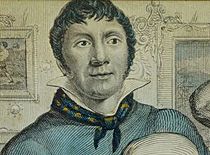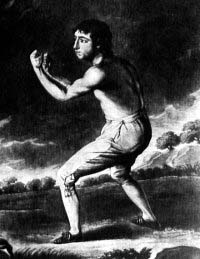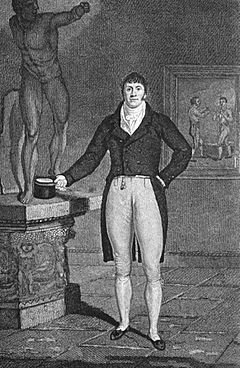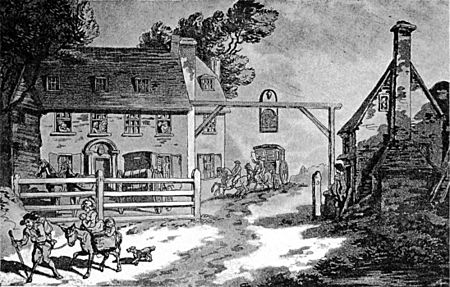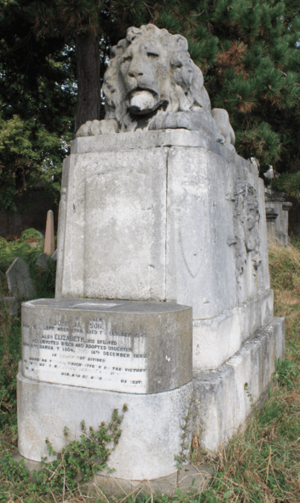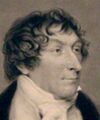John Jackson (English boxer) facts for kids
Quick facts for kids John Jackson |
|
|---|---|
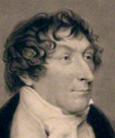
Jackson at 52, posing for artist, circa 1821
|
|
| Statistics | |
| Nickname(s) | "Gentleman" John Jackson |
| Rated at | About 14 stone |
| Height | 5 ft 11 in (1.80 m) |
| Nationality | English |
| Born | 1769 London, England |
| Died | 7 October 1845 (aged 76) Mayfair, London, England |
| Stance | Orthodox |
| Boxing record | |
| Total fights | 3 |
| Wins | 2 |
| Losses | 1 |
| Draws | 0 |
John Jackson (born 1768, died 1845) was a famous English boxer from the late 1700s. He became the bare-knuckle boxing champion of England in 1795 after beating Daniel Mendoza. Jackson was known as "Gentleman" John Jackson because he came from a middle-class family. This was unusual for boxers at the time.
Contents
John Jackson's Early Life and First Fights
John Jackson was born in London in 1768. His family was from Worcestershire, and his father was a well-known builder. Most boxers back then came from poorer backgrounds. Jackson's middle-class roots earned him the nickname 'Gentleman' Jackson.
When he was at his best, Jackson was 5 feet 11 inches tall and weighed about 88 kilograms (195 pounds). His strong and balanced body made him a popular model for artists. At 19, Jackson started going to boxing schools. He showed great talent and quickly found important supporters.
Jackson's First Boxing Match
On June 9, 1788, Jackson had his first professional fight. He fought William Fewterel of Birmingham at Smitham Bottom, near Coulsdon. Fewterel was a tough opponent, having won 18 fights before.
A report from that time says Fewterel was very big. People wondered if Jackson could knock him down. But Jackson did knock him down whenever he landed a good punch. The fight lasted one hour and seven minutes. Fewterel often fell without being hit and stayed down for a long time. The judges had to remind his helpers about the time limit for getting up. Fewterel eventually gave up. The Prince of Wales, who was watching, gave Jackson a banknote as a prize.
The famous artist James Gillray was also there. He made a popular drawing about the fight.
Jackson's Second Fight and an Injury
Jackson's second fight was on March 12, 1789. He faced George 'The Brewer' Ingleston in Ingatestone, Essex. Ingleston had been trained by the champion, Tom Johnson. Ingleston was taller than Jackson and known for hitting very hard, though slowly.
At the start, bets were even. Jackson landed the first knockdown punch. By the fourth round, Jackson was favored to win. But the stage got wet from rain, and Jackson slipped. He dislocated his ankle and broke a small bone in his leg. Because of this injury, he had to give up, and Ingleston won.
Jackson offered to be tied to a chair to keep fighting if Ingleston would also fight from a chair. But Ingleston refused. For the next six years, Jackson did not have any more professional fights. He likely continued working in his family's building business and as an artist's model. However, he stayed involved in boxing. He helped other boxers, like Richard Humphries and Bill Warr, in their fights against Daniel Mendoza.
Becoming the English Boxing Champion
Jackson's experience watching champion Mendoza helped him in 1795. He was set to fight Mendoza for a prize of 200 guineas. The fight happened on April 15, at Hornchurch, Essex. It took place on a stage in a natural dip in the ground, which could hold over 3,000 people.
Jackson was five years younger than Mendoza, 4 inches taller, and about 19 kilograms (3 stone) heavier. Mendoza was a very experienced fighter who had beaten bigger opponents before. This was only Jackson's third fight. Before the match, people were unsure who would win. Bets were slightly in Mendoza's favor.
The fight started slowly, with no punches thrown for the first minute. By the third round, Mendoza seemed to be winning, and bets changed to favor him even more. In the fourth round, the fight started to turn Jackson's way. He cut Mendoza's right eye. In the fifth round, Jackson grabbed Mendoza's hair and held him down, hitting him several times. Mendoza fell to the ground. Mendoza's friends shouted "foul!" but the judges said it was fair. Now, bets were strongly in Jackson's favor.
Mendoza did not recover after this. Jackson controlled the next four rounds. Mendoza gave up after falling at the end of the ninth round. The fight lasted only 10 minutes and 30 seconds. Everyone agreed it was a very tough fight for such a short time. Jackson was barely hurt, jumping off the stage easily. Mendoza, however, was very beaten up.
Jackson's Time as Champion
After beating Mendoza, Jackson's reputation as champion was so high that no one challenged him for several years. There were no official boxing organizations or championship belts back then. So, it's not clear exactly when he retired. He is generally thought to have been champion until Jem Belcher became champion in 1800. Jackson did not argue with Belcher's claim to the title. Mendoza challenged Jackson to a rematch around this time. But Jackson wrote a letter in a newspaper on December 1, 1801, saying he had retired from boxing. This was his first public statement about retiring.
Jackson's Boxing Academy
With his new fame, Jackson opened a boxing academy for gentlemen. It was at 13 Bond Street in London, where he also lived. He was highly respected as a boxer and as a teacher. His academy was very successful. It was said that "Not to have had lessons of Jackson was a reproach." Many important people of the time trained with him.
One of Jackson's students was the famous poet Lord Byron. Byron loved boxing and wrote in his diary that Jackson regularly taught him. He even mentioned Jackson in his poem Don Juan. Most of the training at Jackson's academy involved students wearing 'mufflers' (which are like boxing gloves).
Jackson was known for being kind and generous. He organized boxing shows to raise money for charity. In 1811, he raised £114 to help people in Portugal whose towns were destroyed by the French. In 1812, he raised £132 to help British prisoners in France.
Starting the Pugilistic Club
On May 22, 1814, Jackson helped create the 'Pugilistic Club'. This club helped set rules for professional boxing. It also collected money from rich supporters to add to the prize money for fighters. The club also worked to stop dishonest behavior. Before fights, someone was chosen to hold the large sums of money put up by the fighters' supporters. Jackson often did this important job.
The Pugilistic Club also helped settle arguments between fighters or their supporters. Club officials kept order at fights. They wore blue and buff uniforms, and the ropes around the boxing ring had the letters 'P.C.' on them.
Jackson often attended fights and acted as a referee, solving any rule disputes. After each fight, Jackson showed his generous nature by collecting money for the defeated boxer.
In June 1814, Jackson was asked to put on boxing shows for important visitors. These included the Emperor of Russia, the King of Prussia, and the Prince Regent (who later became King George IV). Jackson performed alongside other famous boxers like English champion Tom Cribb, Jem Belcher, Ned Painter, Bill Richmond, and Tom Oliver.
In 1821, Jackson was asked to provide 18 famous boxers to keep order at King George IV's Coronation. They all wore royal page uniforms for the event. The King had loved boxing when he was younger and had seen Jackson's first fight.
Later Life and Legacy
Later in his life, John Jackson owned the Cock Hotel. This was a coaching inn in Sutton, on the road from London to Brighton.
Death and Recognition
John Jackson died on October 7, 1845, at his home in London. He was said to be holding the hand of his beloved niece, Elizabeth, whom he had adopted. He was buried in Brompton Cemetery in London. His many friends and admirers paid over £400 for a monument with a carved lion on his tomb.
Jackson's boxing skills were recognized long after his death. He was added to the Ring Boxing Hall of Fame in 1954. He was also inducted into the International Boxing Hall of Fame in 1992.
Lord Byron called Jackson the "Emperor of Pugilism." Pierce Egan, a leading boxing reporter, called him the "fixed star" of the boxing world.
Images for kids


